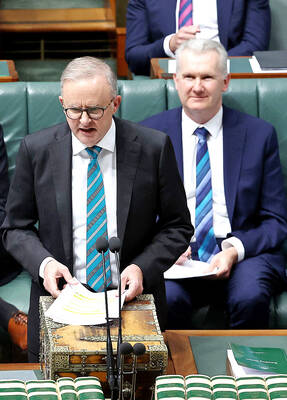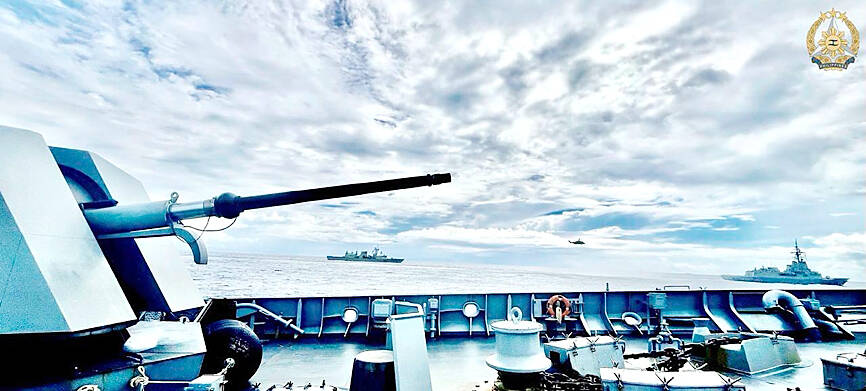The music is still playing and the alcohol is still flowing at the bars along one of the party streets in Vang Vieng. Inside a popular venue, a voice over the speaker announces a special offer on beers, as disco lights flicker on the floor. Small paper flags from nations across the world — from the UK to Gabon — hang from the ceiling.
Young people travel from all corners of the globe to party in the small town nestled in the Laos countryside, but Vang Vieng is under a global spotlight, following a suspected mass methanol poisoning that killed six foreign tourists: two teenagers from Australia, two Danish citizens, a Briton and an American.
The Laos government has promised justice and says it is investigating, but there are concerns about how thorough and transparent any inquiries would be in the country, a communist, one-party state that Reporters Without Borders has described as “an information ‘black hole’ from which little reliable information emerges.”

Photo: AFP
The tragedy has also prompted wider discussions about the risk of contaminated alcohol in Southeast Asian countries — and how young tourists stay safe while travelling.
Before the deaths earlier this month, most backpackers did not think much about what might be in the free shots that are often offered at hostels and bars in Vang Vieng and many other parts of the backpacker trail.
News spread quickly among backpackers, said Eliza Rolf, 21, from the UK. “In the hostel we were last in, all the friends that we made were very paranoid about what to drink.”
No one is drinking spirits anymore, they said.
At the Mad Monkey hostel, a sign at the bar urges guests to be aware of a serious incident of alcohol poisoning “at another hostel,” adding, “Please avoid this for your safety and drink reputable branded spirits.”
However, most backpackers said their hostels and bars have not mentioned the deaths, or said anything about how to stay safe.
One business owner said he believes the recent contaminated alcohol was an isolated incident. Another said the tragedy should bring wider change to make the town safer.
“We’re hoping that something like this will push the go button on the endeavor to regulate the supplies to the tourist market — things like backyard distilleries and so forth,” said one hotel owner, who asked to remain anonymous.
Homemade alcohol is fairly common in Laos and other countries in the region, but it can be highly dangerous if it is produced incorrectly, or if unscrupulous makers try to cut costs by adding methanol as a cheap alternative to ethanol.
State media said that eight people who worked at the Nana hostel where some of the tourists were staying, including its manager, have been detained for ing.
Reporting of the deaths in local media has been minimal, due to the lack of press freedom.
The police have released very little information about their inquiries. The lack of communication has not helped boost confidence in the process.
Vang Vieng, once famous for its raucous parties, has weathered various scandals over the years.
The town was in the past known for “tubing,” where backpackers float along the Nam Song river on the inner tube of a tractor tire, stopping off at bars along the way to enjoy buckets filled with cheap spirits, and throw themselves down giant slides and rope swings.
A spate of tourist deaths eventually forced a government crackdown and it imposed a temporary ban on tubing in 2012.
Today, the town attracts a much wider variety of tourists, and guests are drawn to more than just its party scene. In the crisp morning sunshine, tourists in kayaks splash along the waters of the river, the jagged mountains looming behind them. Stalls in the town offer excursions to the nearby blue lagoons and water caves, and hot air balloon trips above the surrounding rivers and rice paddies.
At night, hotel signs glow in multiple languages — Lao, English, Korean and Chinese — a sign of how the town is powered by tourists from around the world.
In the bars, most tourists are sticking to branded beer or soju.
Those who do buy cocktails are at times hesitant. A young tourist and his friend hand a jug of luminous blue liquid back to the bar staff, complaining it is too strong.
“What’s in it?” they asked. The bar staff pour in an extra can of soda, and take a sip to prove it is safe.
Later into the evening, a voice starts to warble over a microphone. On the streets outside, vendors sell sandwiches and smoothies to passersby, their stalls illuminated by lamps beneath umbrellas.
Dogs slumber on the roadside, watching out for snacks. Across town, music thumps from a bar busy with dancing revelers. For now, the party goes on in Vang Vieng — but with an added dose of caution.

Australia has announced an agreement with the tiny Pacific nation Nauru enabling it to send hundreds of immigrants to the barren island. The deal affects more than 220 immigrants in Australia, including some convicted of serious crimes. Australian Minister of Home Affairs Tony Burke signed the memorandum of understanding on a visit to Nauru, the government said in a statement on Friday. “It contains undertakings for the proper treatment and long-term residence of people who have no legal right to stay in Australia, to be received in Nauru,” it said. “Australia will provide funding to underpin this arrangement and support Nauru’s long-term economic

‘NEO-NAZIS’: A minister described the rally as ‘spreading hate’ and ‘dividing our communities,’ adding that it had been organized and promoted by far-right groups Thousands of Australians joined anti-immigration rallies across the country yesterday that the center-left government condemned, saying they sought to spread hate and were linked to neo-Nazis. “March for Australia” rallies against immigration were held in Sydney, and other state capitals and regional centers, according to the group’s Web site. “Mass migration has torn at the bonds that held our communities together,” the Web site said. The group posted on X on Saturday that the rallies aimed to do “what the mainstream politicians never have the courage to do: demand an end to mass immigration.” The group also said it was concerned about culture,

ANGER: Unrest worsened after a taxi driver was killed by a police vehicle on Thursday, as protesters set alight government buildings across the nation Protests worsened overnight across major cities of Indonesia, far beyond the capital, Jakarta, as demonstrators defied Indonesian President Prabowo Subianto’s call for calm. The most serious unrest was seen in the eastern city of Makassar, while protests also unfolded in Bandung, Surabaya, Solo and Yogyakarta. By yesterday morning, crowds had dispersed in Jakarta. Troops patrolled the streets with tactical vehicles and helped civilians clear trash, although smoke was still rising in various protest sites. Three people died and five were injured in Makassar when protesters set fire to the regional parliament building during a plenary session on Friday evening, according to

STILL AFLOAT: Satellite images show that a Chinese ship damaged in a collision earlier this month was under repair on Hainan, but Beijing has not commented on the incident Australia, Canada and the Philippines on Wednesday deployed three warships and aircraft for drills against simulated aerial threats off a disputed South China Sea shoal where Chinese forces have used risky maneuvers to try to drive away Manila’s aircraft and ships. The Philippine military said the naval drills east of Scarborough Shoal (Huangyan Island, 黃岩島) were concluded safely, and it did not mention any encounter with China’s coast guard, navy or suspected militia ships, which have been closely guarding the uninhabited fishing atoll off northwestern Philippines for years. Chinese officials did not immediately issue any comment on the naval drills, but they